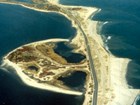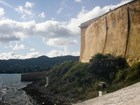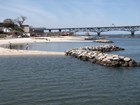Hard structures are often placed in coastal environments to counteract erosion in sediment-deficient areas, or to deter accretion in sediment-rich areas such as inlets. Unfortunately, anthropogenic modifications such as groins, jetties, seawalls, revetments, and breakwaters significantly alter natural shoreline processes and have far-reaching effects.
-
Article 1: Groins and Jetties

Groins and Jetties are shore perpendicular structures used to maintain up-drift beaches, restrict longshore sediment transport, or control inlet migration. These structures may significantly destabilize the coastal system and disrupt natural sediment regimes. Read more
-
Article 2: Seawalls, Bulkheads, and Revetments

These shore parallel structures are designed to protect resources behind them from the impacts of wave energy and associated erosion. However, reflected wave energy often accelerates erosion in front of the structure or at adjacent beaches. Read more
-
Article 3: Breakwaters, Headlands, Sills, and Reefs
These structures are designed to alter the effects of waves and slow coastline erosion and change. They allow for the accretion of sediment between the structure and the shoreline, however, may impede longshore transportation of material. Read more

